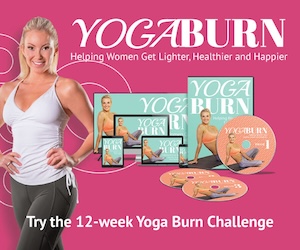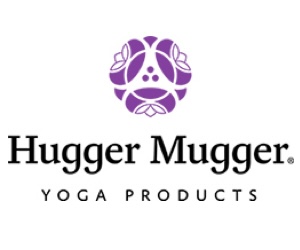Stretching With Yoga Blocks:
Yoga blocks can be used by both advanced and beginner yogis. However, are not a must have in many individual routines. But should they be more often, may be the real question? This useful yoga tool can help in several different ways. For example, stretching further, getting into poses with more ease and comfort, as well as helping gain additional flexibility and balance, during asanas. This post is all about stretching with yoga blocks.
Yoga blocks have been around for many years. They are one of those yoga props that can be highly under-utilized within daily yoga sessions. Oftentimes, yoga blocks are underutilized for a few reasons. Firstly, a lack of knowledge on the appropriateness of using them. Secondly, due to guilt of using them. Often, yogi’s think of blocks as a “crutch”, instead of tool to advance there practice, or make there practice safer.
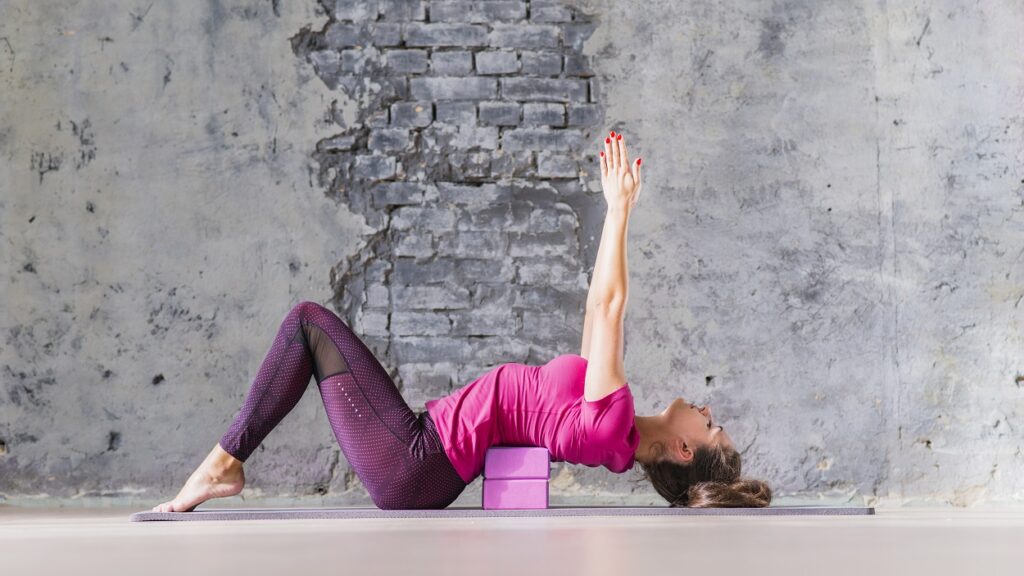
However, having the knowledge and knowhow, can lead to:
- gains in overall body strength,
- correcting body alignment during poses,
- protecting the wrists and other joints during a difficult pose,
- as well as sitting deeper into a particular pose.
Related Article: What Are Cork Yoga Blocks & Why You Should Start To Include Them In Your Routines
If you’re unsure of some of the basic maneuvers you can use yoga blocks for, then you’re in luck. Today, we’ll discuss how yoga blocks can be used specifically to stretch, with some very common yoga poses.
What Are Yoga Blocks?
Yoga blocks are a type of yoga prop that can aid you during your practice. Again, yogis of all skill levels can use this tool to enhance their yoga practice. It is not cheating to use blocks! In fact, yoga blocks can help your body get used to more advanced poses, more easily. Oftentimes, they are used as an extension of ones hands.
If you are a beginner, blocks can keep your body stable and strong as you learn new yoga poses. In time, as the block helps to realign and stabilize your body, you will become more flexible and agile. They are oftentimes used in poses where we need extra support in the back, hip and head region. Just like you will most likely be more comfortable on a yoga mat, a block is another tool that can help in this dimension.
In another post, we’ll discuss more specifically about yoga blocks, however here is a quick reference guide to materials and sizes you may find. Thus, allowing you to choose the right one for your needs.

Materials:
Generally speaking the materials that will make up a yoga block are foam, cork or wood.
Wood
As you would imagine, wood (bamboo, birch, maple or pine), oftentimes is the heaviest of the options. (Weight of around 1-3lbs, however some of these woods are also light in nature). The obvious advantage, is with longevity.
For beginners, or those of us looking to use blocks to hold poses for extended periods of time, like in restorative yoga, they may not be the best option. There are also drawbacks when it comes to getting deeper into your sessions. Wood blocks tend to get more slippery, with sweat, as opposed to the cork or foam options.
Related Article: Restorative Yoga with Bolsters or Blocks, Along with Some Beginner Poses
Cork:
Cork blocks are an extremely popular option as well, offering a lighter, and eco-friendly option. These are also very stable and long lasting, while offering a better grip. The one drawback is not with sturdiness, but often times has to do with odor. Over time, cork yoga blocks absorb moisture (like sweat), so keep this in mind.
Foam:
Oftentimes foam is the best option for beginner yogis. They are soft, superlight (3-10oz in general), and tend to offer more comfortability when using them for extended poses. Furthermore, are usually cheaper!
Longevity is probably the one drawback.
Sizes:
One of the most recognized or “best size” for yoga blocks is 9 x 4.5 x 3 inches. With that being said, they come in a multitude of sizes. Likewise to the yoga practice, there is often not a “one style fit’s all” and in this case, not a “one size fits all”.
Much of the difference in size preference has to do with:
- size of the individuals hands
- flexibility level
- ability level within the practice
- how many you use during a particular pose
They are called yoga blocks or “bricks” for a reason, as they are shaped like a block or a brick, rectangular in size, most often. However, there are other cylindrical ones on the market, which may work better with back-bend type maneuvers and/or asanas.
Stretching With Yoga Blocks + Poses
As beforementioned, yoga blocks come in all kinds of sizes, material, and even colors. If you are looking to get deeper into certain asanas or explore more advanced ones, we definitely recommend using the yoga block, as a tool.
Once you get your block, there are several ways you can stretch with it. Yoga blocks can help you lengthen, strengthen, or support the body.
However, we’ll talk specifically about how you can stretch with a yoga block in the next section.
Related Article: A How to, and Benefits Guide to Yoga Blankets!
1. Triangle (Utthita Trikonasana Block)
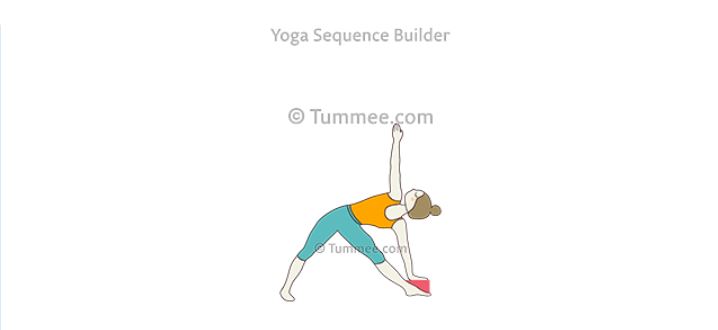
A fairly common yoga pose to begin; the Extended Triangle Pose with a yoga block. Utthita Trikonasana is straightforward, and a relatively beginner-friendly pose, done in the standing position.
When using blocks in this pose, you will be able to sink deeper into the posture, opening up the chest and hips. Above all, if you are having difficulty comfortably touching the floor with your hands or fingertips, a block works great.
This is a side-bend type pose, focusing on both stretch and balance, benefiting the core, chest, hamstrings, and hips.
If you have tight hamstrings, or you need to work on leg flexibility, a block can be useful when doing Triangle pose.
Steps:
1. Firstly, place your block on the ground outside of your front foot. Then continue into the pose, using the block to aid in comfort.
2. Get into Tadasana, then spread your feet out-wide. One foot should be facing forward, the other foot should be at a 90-degree angle, behind. In this instance, your right foot should be in front, with the yoga block to the outside, and the left foot back, toes should be facing the left wall.
3. Then, with arms parallel to the ground, exhale and bend (at your hip) to the right, where the torso is now over the right thigh/leg area.
4. Help stabilize your body by strengthening the back leg, and pressing the left heel into the ground. Now, begin to twist the torso to the left, bringing the left arm towards the ceiling and right hand stabilizing on the yoga block on the outside of the front (right foot).
5. Continue to hold this pose for a few breath cycles.
2. Forward Bend (Ardha Uttanasana Block)
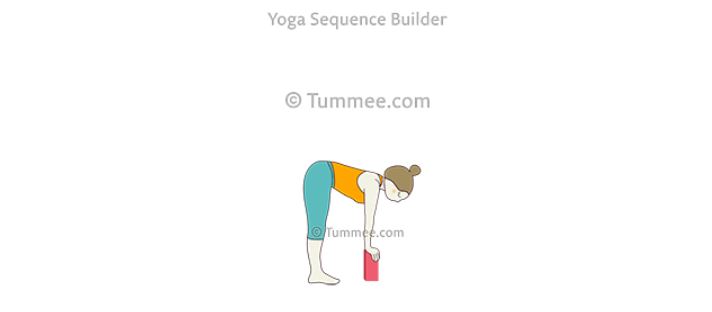
Ardha Uttanasana with a block is another great beginner-friendly pose that can help build-up flexibility and stretch in a safe manner. If you can’t quite reach the ground, stretching with a yoga block can be helpful, and as you progress you can change the height of the block by placing it on its side for a farther stretch.
The Forward-Bend (a forward-bend & stretch-type pose) is a common pose, done in the standing position. It can benefit areas of your body including, the lower back and hamstrings.
Steps:
1. Firstly, get into Mountain pose, placing the block on the ground at a comfortable height in front of your feet.
2. Then, while exhaling begin to bend at this hips, attempting to bring the hands down to the yoga block.
3. At first, you may bend the knees slightly, but as you sit into the pose, attempt to straighten them out, to get a full stretch of the lower back and hamstrings.
4. Breath for a 3-5 count. Release the pose by bending at the knees, straightening the back-out once again.
3. Downward Dog (Adho Mukha Svanasana Blocks)
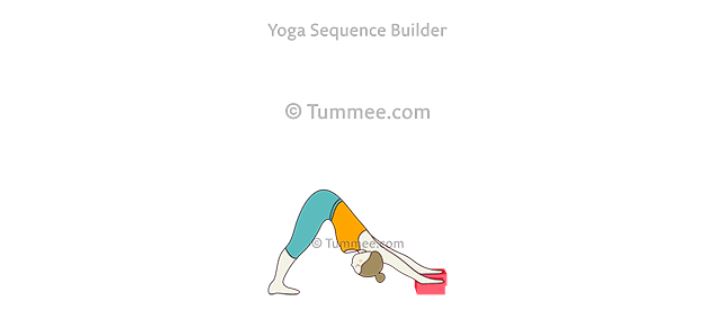
One of the more highly recognizable poses within the practice of yoga, Downward Facing Dog, is another forward-bend, stretch type asana. You can actually use two blocks for this asana. Furthermore, using a prop for this posture can help you gain the strength and flexibility you need to do this pose correctly.
Adho Mukha Svanasana with blocks benefits several areas of the body such as the core, arms, shoulders, back and hamstrings.
Steps:
1. Start the downward dog on all fours with a block under each hand. The blocks should be shoulder width at the front of your mat, lengthwise.
2. Then, place one hand (palms-down) on each block, shoulder width.
3. Next, press into the toes, start lifting your knees and hips (toward the ceiling & back) slowly, pushing up with your feet. Then, press outward through the fingers and edges of your hands.
4. As you continue to move the hips up and back, press the heels into the mat, stretching the calves.
5. Attempt to keep your back in straight alignment. You’ll want to ease into this pose, not rush it.
6. The head and neck positioning may vary slightly, but should relatively be hanging freely, or looking up at the abdomen.
7. Breath for 3-5 cycles. Then bend the knees, lowering the hips, legs and torso back down to all fours.
4. Staff Pose (Dandasana On Blocks Vinyasa)
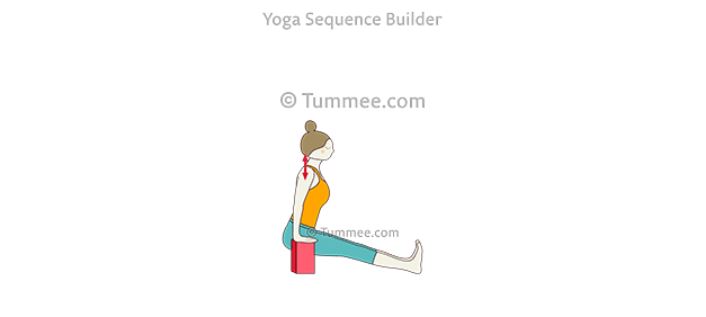
This next pose is a little more advanced. However, with the aide of a yoga block, you can get into this pose easier. It can benefit areas of the body including the arms and core. Dandasana Vinyasa is mostly a strength, and balance type-pose.
Steps:
1. To start this pose, sit down with your legs out in front of your torso.
2. Then, place a block on either side of you, directly positioned below your shoulders.
3. Drop the shoulders back, and chest out, keeping the spine in a straight alignment.
4. With your hands (palms-down) on the yoga blocks, attempt to push into the blocks, lift your buttock & legs off the ground.
5. Finally, attempt to straighten your arms, but be careful not to fully lock your elbows. The back of your feet will remain on the mat.
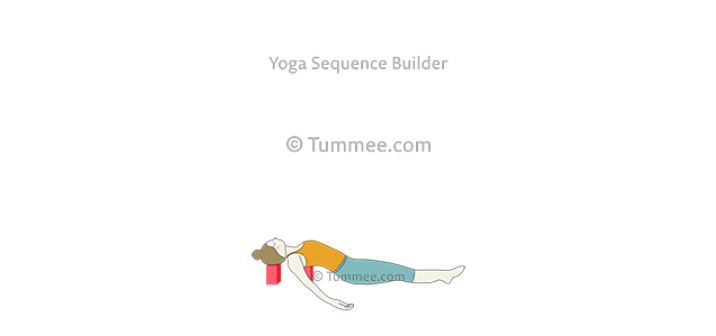
5. Fish Pose (Matsyasana Blocks)
The final pose we’ll talk about on this list of stretches with yoga blocks, is the fish pose. Matsyasana is a common pose found in restorative yoga routines, done in the supine position. It can be beneficial to the chest, neck and spine.
Steps:
1. Easily transition into Fish pose from the above Staff pose once coming down to the mat. With your legs again straight out in front, position each block at the same height.
2. Then, position one block under your shoulder blades and the other, under the back of your head.
3. Once lying back, allow your arms, palms-up, to rest at the side of your body, straight outward from your torso.
4. Your feet can be relaxed and allowed to fall open.
5. Your shoulders should be relaxed and fall off to the side of the yoga block. Relax the body.
6. Breath and hold this position for 1-3 minutes.
Final Tips & Thoughts!
There are many other stretches and poses you can try out with a yoga block, but these are just a few of the most basic and effective postures you can do. Hopefully, you have a good understanding of how to use some poses to safely stretch with a yoga block, and how you can benefit from this great yoga tool!
Remember to take your practice slowly, and stay patient with yourself. Yoga is about bringing balance to the body. Don’t be ashamed to use yoga aids, these are simply to help make yoga safer and more capable of being done, for each individual yogi. With a yoga block, you can give your body time to learn poses and gain the strength and flexibility it needs to correctly perform in the practice.
As always, thanks for stopping by, we hope to have you again soon!
Resources:
- https://camillestyles.com/wellness/8-block-poses/
- https://www.24life.com/24-ways-to-use-a-yoga-block-in-your-workout/
- https://www.yogajournal.com/blog/10-ways-to-use-blocks-to-advance-your-yoga-practice
- https://www.yogabasics.com/connect/yoga-blog/how-to-choose-the-perfect-yoga-block/

